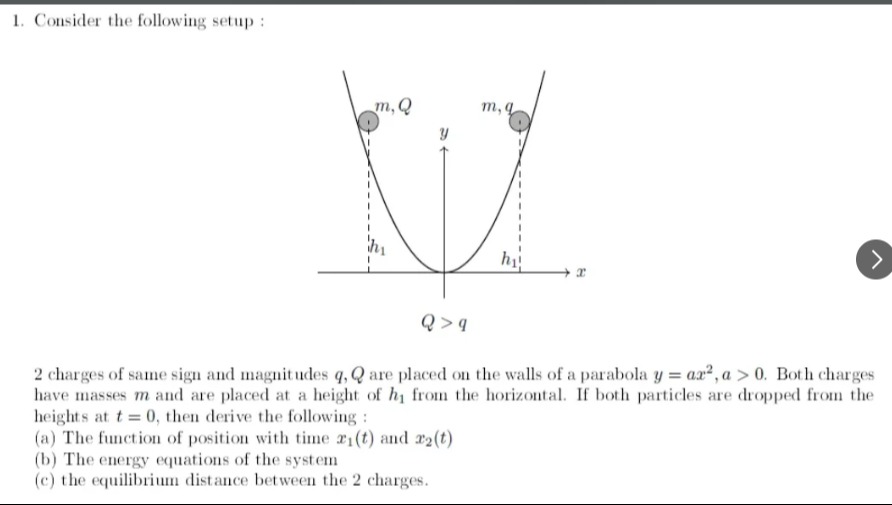Question
Question: Consider the following setup: 2 charges of same sign and magnitudes $q, Q$ are placed on the walls ...
Consider the following setup:
2 charges of same sign and magnitudes q,Q are placed on the walls of a parabola y=ax2,a>0. Both charges have masses m and are placed at a height of h1 from the horizontal. If both particles are dropped from the heights at t=0, then derive the following:
(a) The function of position with time x1(t) and x2(t) (b) The energy equations of the system (c) the equilibrium distance between the 2 charges.

(a) x1(t)=−x(t) and x2(t)=x(t) with
m[(1+4a2x2)x¨+4a2xx˙2]=−2mgax+2x2kQq,x(0)=h1/a,x˙(0)=0.(b) Total energy
E=21m[(1+4a2x12)x˙12+(1+4a2x22)x˙22]+mga(x12+x22)+∣x2−x1∣kQq.For symmetry,
E=m[21(1+4a2x2)x˙2+gax2]+2xkQq.(c) Equilibrium when
8mgax03=kQq⟹x0=(8mgakQq)1/3,deq=2x0.Solution
Overview:
This problem involves analyzing the motion of two charged particles constrained to move along a parabolic path under the influence of gravity and electrostatic repulsion. The solution involves:
- Parameterizing the motion along y=ax2 so that kinetic energy becomes 21m(1+4a2x2)x˙2.
- Writing the potential energies: gravitational mgax2 for each and Coulomb kQq/(2x) (since d=2x).
- Using Lagrange’s equations (or energy conservation) one obtains the differential equation for x(t); hence the positions x1(t)=−x(t) and x2(t)=x(t).
- Minimizing the potential energy U(x)=2mgax2+2xkQq with respect to x yields the equilibrium position x0=(kQq/(8mga))1/3 and so the equilibrium distance is deq=2x0.
Detailed Steps:
Equations of Motion:
Because each particle is constrained to lie on the parabola y=ax2 the arc‐length is
s(x)=∫0x1+(y′)2dx=∫0x1+(2ax)2dx=∫0x1+4a2x2dx.Thus the velocity is
v=dtds=1+4a2x2x˙.Hence the kinetic energy for a particle is
K=21m(1+4a2x2)x˙2.Now, for the two particles (we label the left one “(m,Q)” and the right one “(m,q)” with Q>q) the energy contributions are:
- Gravitational potential energy (using y=ax2) for each is Ug=mgax2.
- Their mutual Coulomb potential energy is Ue=dkQq, where the distance between them is, when symmetric, d=(x2−x1)2+(a(x22−x12))2. But for x1=−x,x2=x we have x2−x1=2x and x22−x12=x2−x2=0, so that d=2∣x∣.
Thus the Coulomb energy is
Ue=2∣x∣kQq.A Lagrange–Newton treatment along the x–coordinate leads to the equation of motion
mdtd[1+4a2x2x˙]=−dxd[mgax2+2∣x∣kQq].In explicit form one may write
m[(1+4a2x2)x¨+4a2xx˙2]=−2mgax+2x2kQq,where (for x>0) we have dropped the absolute value. Then the positions of the two charges are
x1(t)=−x(t),x2(t)=x(t),with the above differential equation governing x(t). (One may “solve” for t in terms of x by writing
t=∫x(0)x(t)m2[mga(x(0)2−x2)+2kQq(x1−x(0)1)]1+4a2x2dx,where x(0)=h1/a, the initial position along x, since the particles are dropped from a height h1 above x-axis.)
Energy equations
The total energy of the two–particle system is conserved. For each particle the energy is
- Kinetic: Ki=21m(1+4a2xi2)x˙i2,
- Gravitational potential: Ug,i=mgaxi2.
Thus, if we write the energies for the two and add the Coulomb interaction, the conserved energy reads
E=21m[(1+4a2x12)x˙12+(1+4a2x22)x˙22]+mga(x12+x22)+∣x2−x1∣kQq.For the symmetric case x1=−x and x2=x this becomes
E=m[21(1+4a2x2)x˙2+gax2]+2∣x∣kQq.Equilibrium distance
In equilibrium the forces along the tangent vanish. Equivalently the energy is minimized with respect to x. For the symmetric case, the potential energy (of the system) is
U(x)=2mgax2+2xkQq(x>0).Setting dxdU=0 we get
dxdU=4mgax−2x2kQq=0.Thus,
4mgax=2x2kQq⟹8mgax3=kQq.Therefore,
x0=(8mgakQq)1/3.Since the charges are separated by a horizontal distance of 2x, the equilibrium distance is
deq=2x0=2(8mgakQq)1/3.